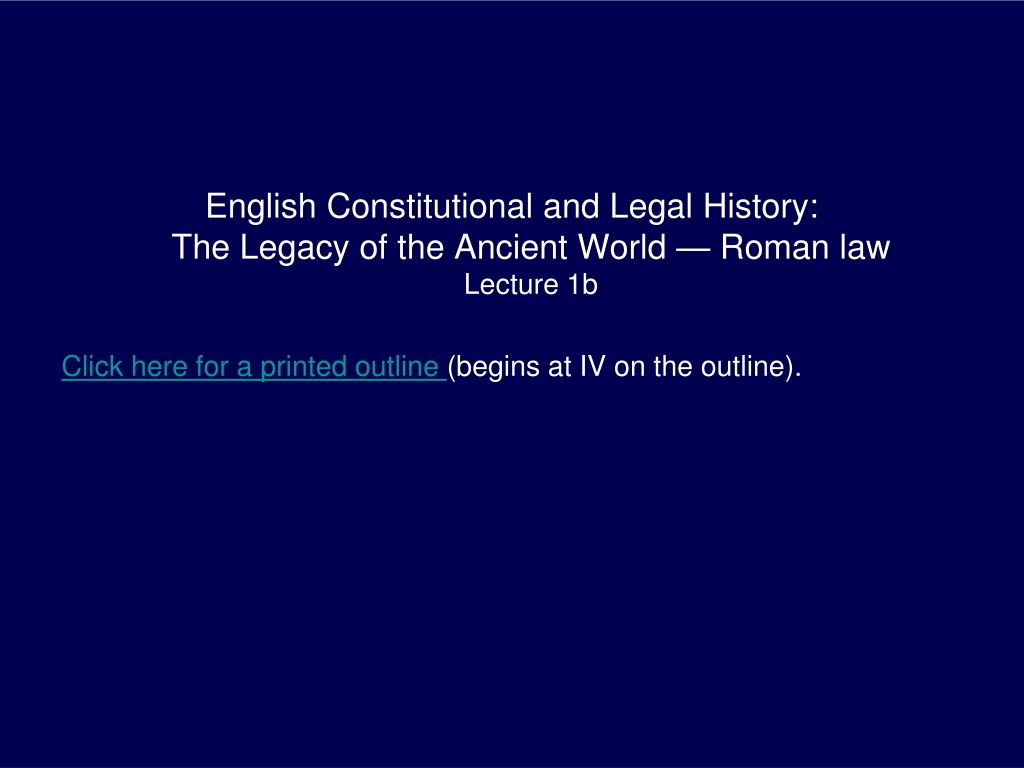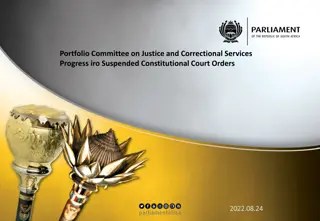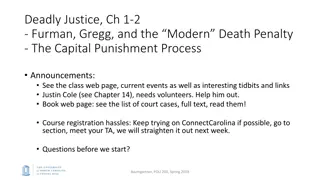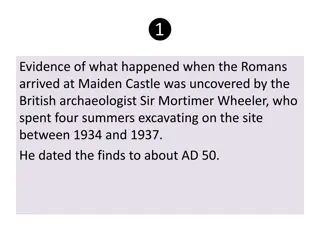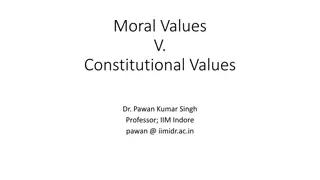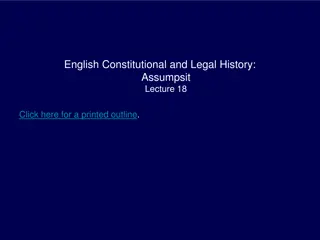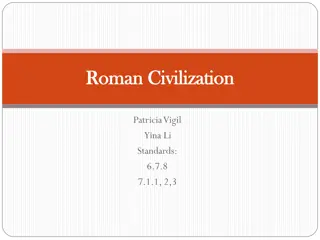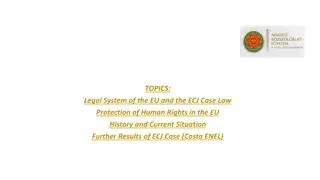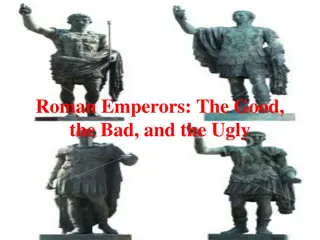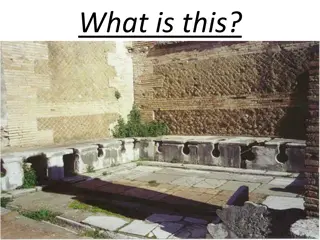Evolution of Legal Systems: Roman and English Constitutional History
Explore the evolution of legal systems in Roman and English history, tracing the development of laws, procedures, and political structures from ancient times to the medieval and early modern eras. Understand the impact of politics on legal sources and the intricate relationship between state control and procedural evolution.
Uploaded on Nov 22, 2024 | 0 Views
Download Presentation

Please find below an Image/Link to download the presentation.
The content on the website is provided AS IS for your information and personal use only. It may not be sold, licensed, or shared on other websites without obtaining consent from the author. Download presentation by click this link. If you encounter any issues during the download, it is possible that the publisher has removed the file from their server.
E N D
Presentation Transcript
English Constitutional and Legal History: The Legacy of the Ancient World Roman law Lecture 1b Click here for a printed outline (begins at IV on the outline).
Periodization revisited The last lecture closed with a worry. The worry was whether we had gotten the periodization of English legal history quite right. The reason for the worry is because of the chronology right under that of England in the outline. These are the stages of development of another great legal system the Roman.
Roman constitutional and legal chronology Archaic, Early: 500 BC - 250 BC Republic Pre-classical, Late: 250 BC - 1 BC Classical, Principate: 1 AD 250 AD Empire Post-classical, Dominate, 250 AD 500 AD Codifications of Justinian 529 534 AD Click here for the printed outline
What we see in the printed outline. There is a quite tight, almost definitional relationship between the type of politics and the sources of law (obviously you can t have imperial constitutions as a source of law until you have an emperor). There is also a quite tight relationship between types of procedure and politics and sources of law. Archaic procedure is highly formal; much depends on the consent of the parties; the power of the state is weak. With the elaboration of the law in the pre-classical and early classical periods, the procedure became more informal but was still heavily dependent on the will of the parties. As the empire became more bureaucratic, state officials came to play a more important role in the procedure and appeal to the emperor rather than elaboration by jurists.by jurists became the the most important source of law.
Pretend that medieval England had a constitution in the modern sense? The danger of anachronism and the mistakes of William Stubbs. Pretend that medieval England had a constitution in the modern sense? The danger of anachronism and the mistakes of William Stub Pretend that medieval England had a constitution in the modern sense? The danger of anachronism and the mistakes of William Stub Developmental Parallels. Medieval and early modern Continental Europe: the primitive code phenomenon at the beginning, the development of doctrine by means of quasi-academics, and the drive toward codification. There is also some parallel in the political development, in that until the 19th century the political development showed a tendency toward autarchy, and autarchic rulers tended to take over the legal system. Medieval and early modern England: the primitive code phenomenon at the beginning, the development of doctrine out of the interstices of procedure, the drive toward rationalization and systematization when the props of the procedural system were removed. The political development did not show as much tendency toward autarchy as did the Continental, but it did show enough that conscious change in the legal system became a political issue at much the same time as it did on the Continent.
Why should we worry? Roman legal development was the first one to be studied scientifically. It is possible that legal historians studying both England and Continental Europe dropped down on it a model from Roman law that didn t quite fit. Certainly we should be cautious about assuming that there is anything necessary about stages of development like this. Chinese law, Indian law, Jewish law, and Islamic law do not show stages of development like this one, or show it only at such a general level that the model is not helpful.
The legacy of Roman law the Corpus Iuris Civilis Known and studied in the West from the 12th century onward. In the period from 1300 1500, all the sophisticated lawyers on the Continent obtained university law degrees. In England, a university law degree was not a requirement for those who wanted to rise to the top of the profession. Why did the influence of Roman law remain strong on the Continent while if faded in England? Or should we be talking more about the similarities rather than the differencs? English variation is one among a number of Protestant variations
The legacy of Roman law the structure If we look to structure rather than rules, the underlying structures of English and Continental law are today remarkably similar. When nationalism came to be a force, all countries developed national variations. The different religious settlements in different countries produced different results of which the English variation is one among a number of Protestant variations. Let us take a look at some of the structural categories of Roman law that appear, at different times in English law, and which today are fundamental to legal thinking in both Anglo-American law and Continental law. These categories come from Justinian s Institutes (J.I.), an elementary textbook that begins the Corpus Juris Civilis; it is divided into 4 books, roughly the length of a long chapter in a modern book.
The legacy of Roman law J.I., public vs. private J.I. begins with some generalities, of which the following is notable (J.I.1.1.3 4): The study of law consists of two branches, law public and law private. The former relates to the welfare of the Roman state; the latter to the advantage of the individual citizen. Public law vs. private law is the Roman distinction ours today? Most would probably say that public law is that body of law that deals with the relationship of the state to individuals. Hence, criminal law is archtypically public law. Private law, on the other hand, deals with the relationship of individuals to each other. Property, tort, contract, and family law are archtypically matters of private law. The public-law/private-law distinction has a complicated history in Roman juristic thought, but it appears sufficiently often in Roman juristic writing that we are probably safe in concluding that it is classically Roman, but that does not mean, however, that it was necessarily very precise.
The legacy of Roman law J.I., public vs. private (contd) As applied in Roman law the distinction between public law and private law excludes from the realm of private law religious, administrative, constitutional law, and, probably, criminal law. Since the Roman jurists dealt almost exclusively with private law that means, as a practical matter that the jurists did not consider criminal law in any depth and largely confined themselves to those things about which a private party could bring a law suit. It has recently been suggested that the unconscious purpose of the public/private distinction is to mask the policy nature of what the state is doing in the area of private law. The important thing for our purposes is that the use of the distinction between public and private law comes late to medieval law. This is not surprising in a world that did not think naturally in terms of the individual vs. the state. The distinction between criminal and civil law was, however, a distinction that the medievals picked up relatively soon after the revival of Roman law in the 12th century.12th century
The legacy of Roman law J.I., persons vs. things vs. actions A little later on in the introductory material to J.I., we find (J.I.2.12.) : The whole of the law which we observe relates either to persons, or to things, or to actions. This then becomes the basis for the division of the whole work. The rest of book 1 deals with persons; books 2 & 3 deal with things, and most of book 4 deals with actions. It turns out that the first category, persons, deals with capacity, who has legal rights and duties, and of what kind. The second category, things, is substantive rights and duties, the third is remedies. Who, what and how vindicated. Today we think very little about the law of persons. The abolition of slavery in the west has a great deal to do with that; so does liberalism: Sir Henry Maine s great shift from status to contract. For Justinian full legal capacity rested in free-born, male, Roman citizens, who were not subject to the power of their fathers (sui juris). This does not mean that only they had rights, but we can be sure only of them. Others we must ask about.
The legacy of Roman law J.I., persons vs. things vs. actions (cont d) From a critical standpoint, the function of this trichotomy among persons, things, and action to create a false consciousness. In the case of the first distinction, by splitting off persons from rights and remedies we make rights look better. We mask the fact that very few people had a full panoply of rights. In the case of the second distinction, by splitting off substantive rights and duties from remedies, we, once again, make rights look better. We mask the fact that rights require state enforcement. The English legal system that we will be studying did not make sharp distinctions between and among capacity, substantive rights and duties, and remedies. The capacity question, however, is there from the beginning in medieval law; it antedates the rediscovery of Roman law. So far as the the substance-procedure distinction is concerned it takes a long time for England to develop it, though there are decided hints of it in the early modern period.
The legacy of Roman law J.I., the law of things all law persons (bk. 1) things (bks. 2 3) actions (bk. 4) acquisitions of individual things acquisitions per universitatem obligations delict contract
Where do we go from here? But Roman law, like Christianity, and certainly like the common law, was a long way off when Hengist and Horsa arrived on the Isle of Thanet c. 450. The invaders of England were pagans, and they knew nothing of Roman law. We dealt in this lecture with Roman law as a legacy of the ancient world that eventually returned to England. In the next recorded lecture we ll deal with Christianity, as a legacy of the ancient world that eventually returned to England. Next week, we ll start with Hengist and Horsa, but we ll very quickly get to the return of Christianity. It will take until the following week before we can see anything that looks like Roman law and when we can begin, at least tentatively, to talk about the common law.
